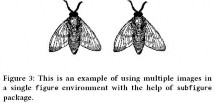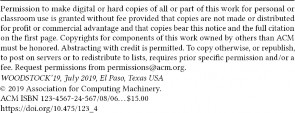LaTeX Best Practices


Best Practices for Submitting a LaTeX Paper/Article
to the acm publishing system (TAPS)
ACM wants to make the submission process as smooth as possible for authors, so we have developed a set of best practices which you should follow to ensure that the submission and conversion process goes as smoothly as possible.
Before submitting your LaTeX source files to TAPS (for proceedings articles) or through the existing journal production process, we encourage authors to review the following points for confirming the smooth processing of your paper:
- ACM has transitioned to a new authoring template. The new ACM Primary Article LaTeX template consolidates the previous eight individual ACM journal and proceedings templates. The templates are updated to the latest LaTeX distribution versions, developed to enable accessibility features, and they use a new font set.
The new LaTeX package incorporates updated versions of the following ACM templates:
o ACM Journals: ACM Small, ACM Large, ACM and TOG (also for SIGGRAPH authors publishing in TOG)
o ACM proceedings templates: ACM Standard and SIGPLAN
All journals use acmsmall with the following exceptions:
o acmlarge - Large single column format, used for JOCCH, TAP
o acmtog - Large double column format, used for TOG
Note: Most proceedings authors will use the "sigconf" proceedings template. If you are unsure which template variant to use, please request clarification from your event or publication contact.
- Use the standard LaTeX code while preparing your manuscript as seen within ACM’s sample template files:
|
For ACM Conferences |
For ACM Journals |
|
sample-sigconf.tex |
sample-acmsmall.tex |
|
sample-sigplan.tex |
sample-acmlarge.tex |
|
sample-acmtog.tex |
|
ACM recommends the authors to check/refer the respective sample TeX file while preparing their papers and use the required option “sigconf | sigplan” accordingly and finalize their work.
Important information regarding submission versions for review: After finalizing the formatting of your paper you must use the option “manuscript” with \documentclass[manuscript]{acmart} command. This will generate the output in single column review format which is required. Accepted manuscripts will be transformed during production to produce properly formatted output accord to the publication specifications. Authors will be provided the opportunity to review and approve the formatted output before the article is published to the ACM Digital Library.
- Please check the list of approved LaTeX packages approved for the processing in TAPS Use of other LaTeX packages are not allowed and will be returned as not ready for publication.
Our team is always accepting recommendations for LaTeX packages in the public domain for review. Please send suggestions to [email protected]
- Avoiding redefining/custom codes for standard LaTeX command. Local Definitions are allowed but special fonts and characters are not allowed. Don’t use unnecessary local definitions that may overlap standard LaTeX commands.
|
\def\beq{\begin{equation}} |
 |
|
\def\eeq{\end{equation}} |
|
|
\def\myfigure#1#2{ \begin{figure}[t]\centering \includegraphics*[width=\linewidth]{\figurePath#1} \caption{#2}\label{fig:#1}\vspace{-5pt} \end{figure}} |
|
|
\def\mycharacter{\char’<Character Position>} |
|
\def\rM{\ensurement{\mathrm{M}}} |

|
- Modifications to the standard page length/layout and other related dimensions that are governed by “acmart” template are not allowed and will be returned for correction. Here are a few examples of commands which must not be used:
|
\renewcommand{\baselinestretch}{<factor>} |

|
|
\linespread{<factor>} |
|
|
\setstretch{<factor>} from “setspace” package |
- The use of \vspace, should only be used to provide space above/below surrounding objects. It is not recommended to disturb the default vertical/horizontal spacing generated by “acmart.cls”.
- Please code all the authors in individual \author{Author Name}, \affiliation{…} and \email{…} commands: Following correct block of code need to available for all respective authors individually:
|
\author{Craig Rodkin, Bernadette Shade, Laura Lander} |

|
|
\author{Craig Rodkin} |
\author{Bernadette Shade} |
\author{Laura Lander} |
||
|
|
|
|
For more information on recommended practices for coding author information please check here.
- Full length manuscripts must contain following information:
CCS Concepts and Keywords
o Abstract, Poster, and other short manuscripts of 2 pages or less may omit CCS Concepts and Keywords
- When submitting manuscripts for publication, the manuscript must contain the ACM Rights Text and Bibstrip data. You will receive correct data to insert into your LaTeX document from ACM’s rights management system via email after completing the ACM eRights form. Here is an example of a proceedings submission:
|
% ACM License Text % DOI % ISBN %Conference Details % Year % Copyright Year |
PDF output of the mentioned LaTeX code:
|
- Figures and tables: The new ACM styles use the standard LaTeX interface for figures and tables. There are some important items to be aware of, however.
- The captions for figures must be entered after the figure bodies and for tables before the table bodies.
- There must be an image within figure environment. Tables are not recommended within figure environment.
- The ACM uses the standard types for figures and tables and adds several new ones. In total there are the following types:
figure, table: a standard figure or table taking a full text width in one-column formats and one column width in two-column formats.
figure*, table* in two-column formats, a special figure or table taking a full text width.
teaserfigure: a special figure before maketitle.
sidebar, marginfigure, margintable: in special sidebars, tables and figures in the margin.
- How to use multiple part image files within a single figure environment: User can use standard subfigure package for this requirement; following is an example:
|
\begin{figure} |

|
For adding labels to the individual images use can add “[]” (optional argument) with the \subfigure command; for example:
\subfigure[]{\includegraphics[height=1in, width=1in]{fly1}}
- Figure Descriptions: ACM is committed to publishing in an accessible format (https://www.acm.org/accessibility) that permits all its readers to have the content presented to them in a thorough and useful way. ACM needs the assistance of its authors to help achieve this goal. It is important that ACM authors provide descriptions for figures in their content so that ACM readers with visual impairment can be given equivalent information for these important images. The short description will be displayed in place of an image if an image cannot be loaded, and the long description provides in-depth image descriptions to search engine crawlers, which helps to properly index the images. The command \Description[short description] {<long description>} should be placed inside every Figure and can also be used for Tables to provide an overview of the structure of a complex table. Figure descriptions are complementary to figure captions and should not repeat the same information. Refer to writing figure descriptions for guidance.
- Figure Balance: The option |balance| determines whether the last page in the two column mode has balanced columns. By default it is |true|; however, it may lead to problems for some documents. When there are many figures near the end of the document, the attempts to balance columns may lead to the loss of the figures. Set this option to |false| if you encounter problems. An alternative is the (experimental) option |pbalance|, which uses the new package |pbalance|. You may want to try |pbalance=true| to see if you get better results.
- Math environment: AMS math commands are recommended when inserting math equations into your manuscript. We take advantage of the AMS math commands within the newly developed HTML output in the ACM Digital Library. We’ve integrated MathJax into the HTML, which not only renders the math correctly, but offers readers the ability to extract the math from the HTML document for reuse.
- References should be organized and formatted with the BibTeX software package, and included in your LaTeX source as follows:
- \bibliographystyle{ACM-Reference-Format}
\bibliography{<NAME OF BIBTEX FILE>}
- Authors' first names should be spelled out, not abbreviated. Sources should be clearly identified: title, year, volume, number, pages, etc.
- Authors of approved papers will receive an email from [email protected] to complete the ACM eRights form. Please complete the form in a timely manner so not to delay publication of your paper. After completion of the ACM eRights form, you will receive another email from [email protected] which contains the commands that need to be inserted into your final LaTeX file in order to generate the proper rights statement and Bibstrip data.
-
After above step you are required to either submit your files to TAPS (The ACM Publishing System) or to your proceedings production contact for submission processing. You will need to package your files in the following way:
You will receive a notification email from TAPS, in which system will ask you to submit your manuscript file and provide a unique link through which you can access TAPS (your specific author dashboard). In the top of your author dashboard TAPS provides the information about “Proceeding Acronym”, “Paper ID” and “Title of Paper”. You can upload a zip file in TAPS for further processing and the ZIP file naming should be like: <Proceeding Acronym>-<Paper ID>.zip
The ZIP file can contain 3 folders, following is the folder structure inside ZIP file:
<proceeding_acronym>-<paper_ID>.zip
pdf
<file_name>.pdf
source
<supporting_files>
<file_name>.tex
<file_name>.doc
supplements
<file_name>.mp4
<file_name2>.mp4
<file_name>.jpg
readme.txt
<file_name>.ppt
pdf: This folder contains the PDF output of your manuscript. It’s not mandatory to provide this folder.
source: This folder contains final source files MS-Word or LaTeX. This folder should contain all necessary files/resources which are required to generate the final output. It’s mandatory to provide this folder.
supplements: This folder contains the supplementary material which need to available at the time of web publishing. The content of this folder will not appear in PDF output. It’s not mandatory to provide this folder.
You can also check the in information available under “General Instruction and Information” at your TAPS author dashboard. Make sure that your package contains all figures, macros and LaTeX files you used in your paper.
- If your manuscript uses multiple TeX files then make sure that only one TeX file should contain the \documentclass[<options>]{acmart}. In the case of multiple files having this command, TAPS will show a validation error message and ask you to update it accordingly.
- If you are submitting to TAPS, will receive an email notification from TAPS with the unique link for accessing and depositing your package for processing.
Publish with ACM
ACM's prestigious conferences and journals seek top-quality papers in all areas of computing and IT. It is now easier than ever to find the most appropriate venue for your research and publish with ACM.

Lifelong Learning
ACM offers lifelong learning resources including online books and courses from Skillsoft, TechTalks on the hottest topics in computing and IT, and more.


